
Why Australia Had No Slavery, Part II: The North-West
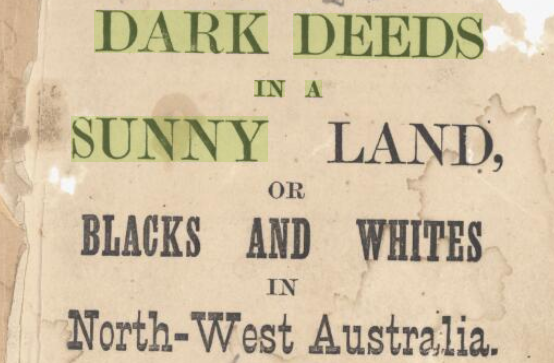
In 1838, the NSW Legislative Council’s Committee on the Aborigines Question, held an inquiry on the possible establishment of a protectorate for the Aboriginal people of the colony. Reverend Lancelot Threlkeld, who ran a mission at Lake Macquarie under the auspices of the London Missionary Society, made a submission to the inquiry advocating what he regarded as best practice for a protectorate at the time. “I am of opinion, that it would be much more beneficial, if an establishment could be formed on the Moravian principle.”
The Moravian Church was formed in Bohemia in the early eighteenth century as part of the movement for the revival of German Protestantism called Pietism. Its adherents became missionaries to the slaves and the Indians of North America and by mid-century a Moravian Church had been firmly established in the New World. In the early nineteenth century, Moravian missionaries from both America and Germany established themselves in the Pacific islands. They also strongly influenced the members of the Evangelical movement who dominated the Anglican, Presbyterian and Methodist Churches in the new British colony of New South Wales. This was largely because of their reputation for being so successful throughout the Polynesian, Micronesian and Melanesian islands, where they had quickly converted chiefs and whole populations to Christianity.
Part III: The Founders
German Pietism was one of the less dogmatic forms of Protestantism, and believed in preserving largely intact the existing cultural traditions of those it converted. Pietists disdained the temptations and pleasures of the material world, especially amusements such as the theatre, dancing and games. The everyday, material world was full of evil and corruption from which one could only be led by the Grace of God. This was best achieved in the environment of a small, self-sufficient community in which civic and church life were integrated in a theocratic society. In New South Wales, these views coincided with those of British Evangelical Protestantism, which shared part of the outlook of Pietism. As a result, the Australian churches helped the Moravians establish themselves in the colony. The influential Presbyterian clergyman and politician, John Dunmore Lang, sponsored the Germans to set up their first mission at Moreton Bay. In 1858, two more Moravian missions were established in the Western District of Victoria.
Pietism predicted a wicked world, so it was to be expected that, when its adherents first looked at the Australian colonies, this was what they found. They were especially concerned to preserve Aborigines from the corruption of white society and to enclose them within a community protected from its influence. The Wesleyan Methodists were the most Pietistic of Australia’s Evangelicals and, when they were setting up their first mission to the Aborigines at Bateman’s Bay in 1827, one preacher urged: “Let the Mission be established at a place where the Blacks are not in communication with the Whites, and my soul for any man’s but his Mission will prosper.”
So the missionary ideal for the Aborigines became a closed religious community, which grew its own food and was largely self-sufficient and, above all, was free of contamination from white society. Assimilation was the road to damnation.
In 1885, the Moravian missionary, F. A. Hagenauer, visited north Queensland and urged the need for missions to the Aborigines there. By the early 1890s, four missions had been established: two by the Lutheran Church to the north and south of Cooktown; one by the Moravians on behalf of the Presbyterian Church at Mapoon on the west coast of Cape York; and one by the Church of England, also with Moravian help, on Cape Grafton.
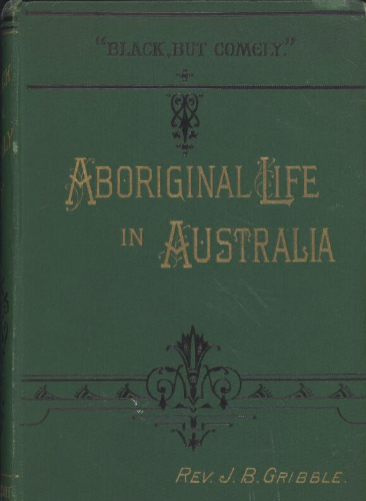 The last was a mission to the Aborigines of the district around Cairns and the Murray Prior Ranges, in the hinterland of Cape Grafton. It was named the Yarrabah Mission and Reverend John Gribble was made its founding clergyman. Gribble became a Methodist minister in 1876 and in 1879-80 he and his wife built and established their own institution, the Warangesda Aboriginal Mission at Darlington Point. In 1883, the Bishop of Goulburn made him an Anglican priest. Although Gribble’s financial mismanagement of Warangesda led to a government inquiry, the Bishop of Perth in 1884 invited him to work in Western Australia. In 1885 he opened an Anglican mission at Carnarvon on the Gascoyne River in the colony’s north west.
The last was a mission to the Aborigines of the district around Cairns and the Murray Prior Ranges, in the hinterland of Cape Grafton. It was named the Yarrabah Mission and Reverend John Gribble was made its founding clergyman. Gribble became a Methodist minister in 1876 and in 1879-80 he and his wife built and established their own institution, the Warangesda Aboriginal Mission at Darlington Point. In 1883, the Bishop of Goulburn made him an Anglican priest. Although Gribble’s financial mismanagement of Warangesda led to a government inquiry, the Bishop of Perth in 1884 invited him to work in Western Australia. In 1885 he opened an Anglican mission at Carnarvon on the Gascoyne River in the colony’s north west.
Gribble’s Western Australian venture, however, was a disaster. Within a matter of months, Gribble had made implacable enemies of the entire settlement on the Gascoyne, the Perth Committee of the Board of Missions, the editors of the West Australian, the Anglican Archdeacon, the Bishop of Perth, as well as the Governor of the colony and his wife. By mid-1886, he was back in New South Wales publicly denouncing all of the above. That year he published a pamphlet, Dark Deeds in a Sunny Land, which outlined his grievances. In his book This Whispering in our Hearts (1998), Henry Reynolds bases most of his story about Gribble on the information in this pamphlet, which Reynolds sees as a courageous exposure of slavery, violence, murder and sexual abuse of Aborigines in Western Australia. By speaking out bravely, Reynolds argues, Gribble earned the enmity of the entire colony, at great cost to his reputation and his health.
However, a perusal of Dark Deeds shows the majority of the deeds Gribble records were done not to the Aborigines but to himself. He lists the following abuses he suffered.
# Within three months of his arrival at Carnarvon, the townspeople had sent two petitions to the Bishop of Perth requesting his removal.
# Two public meetings were held in the township “at which my person and work were thoroughly denounced” and a large placard was posted in the main street saying “Down with Gribble and all his supporters”.
# The town imposed a boycott on him, refusing to provide either his family with food or his mission with building supplies.
# On the ship taking him from Carnarvon to Perth, other passengers tried to assault him and then “laid siege” to him in his cabin for the rest of the journey.
# After Gribble published two articles in the Perth newspapers The Daily News and The Inquirer about abuses to Aborigines, the Board of Missions in Perth passed a resolution expressing its “deep regret” and “the unqualified condemnation of this committee”.
# At a vice-regal lunch on Rottnest Island, he insulted the wife of the Governor, Sir Napier Broome, by belittling her pet project, the construction of Perth’s Anglican Cathedral.
# He later complained to the Governor about the slow pace of the prosecution of those responsible for his shipboard assault. He warned that if the Governor did not act on the matter, he would report him to his superiors in England. When the Governor complained about him to the church, Gribble carried out his threat and sent a formal protest to the Secretary of State for the Colonies about the Governor’s failure to deliver him justice.
# In a debate on “Libellous Statements Published by the Rev. J. B. Gribble” in the Western Australian Legislative Council, he was denounced as a man who “never lost an occasion to malign them, and to tell the most atrocious lies about them ― lies, which, if there was any foundation for them, would hold up the people of Western Australia, and deservedly, to the execration of the civilised world”.
# The editor of the West Australian accused the missionary of being a “lying, canting humbug”. When he sued the newspaper for defamation, the judge found Gribble had showed a “wilful disregard for the truth”. He lost the case and was ordered to pay costs.
Gribble promptly left Western Australia. He was smuggled aboard a steamer in Fremantle and hid in his cabin for five nights until clear of the jurisdiction of the colony. He escaped without paying the costs of his 20-day suit for defamation.
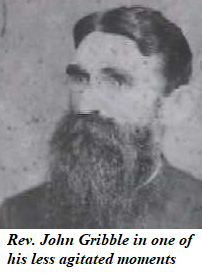 What were the reasons for such pervasive persecution of a lone missionary? Reynolds records but does not fully explain the animosity, putting it down to the way Gribble’s press criticisms threatened the moral standing and economic interests of the frontier settlers. But if you read Dark Deeds, which reproduces his two newspaper articles, it is not difficult to understand. The principal charges he made were about the functioning of what he called “the native labour system”. He concluded that the Western Australians had introduced a system of de facto slavery. Dark Deeds took up the theme with gusto. It compared the African and American slave trades to the conditions of Aborigines in the north west of the colony.
What were the reasons for such pervasive persecution of a lone missionary? Reynolds records but does not fully explain the animosity, putting it down to the way Gribble’s press criticisms threatened the moral standing and economic interests of the frontier settlers. But if you read Dark Deeds, which reproduces his two newspaper articles, it is not difficult to understand. The principal charges he made were about the functioning of what he called “the native labour system”. He concluded that the Western Australians had introduced a system of de facto slavery. Dark Deeds took up the theme with gusto. It compared the African and American slave trades to the conditions of Aborigines in the north west of the colony.
Capture, chains, long marches, whipping, exhaustion, death on the roadside, or if surviving all these, a far more terrible fate in the shape of a living death! Packed like herrings in the slave-dhow; sold like brutes of the field to the highest bidder, on some foreign shore, and then dark, dark, finale, a life, longer or shorter, according to the powers of endurance ― of what? Heaven only knows! Deeds of darkness have been committed not only in Africa and America in connection with the slave trade … But that Australia itself, professedly the new home of liberty and light, should also have become the theatre of the dark deeds of oppression and cruelty … in itself constitutes the foulest blot that could possibly rest upon the escutcheon of Australia’s fame.
Gribble listed all the famous abolitionists of history ― Wilberforce, Brougham, Foxwell Buxton, Woolman, Lincoln, Harriet Beecher Stowe ― and clearly imagined himself standing in their shoes. Melodramatic as this obviously was, it was a particularly offensive charge to make in Western Australia at the time. The transportation of convicts from Britain had been ended by colonial protests only 17 years earlier, in 1868, and there were many people who still remembered the great debate over slavery in the American Civil War twenty years before. As a colony that was both relatively new and geographically isolated, its inhabitants were especially sensitive to outside opinion. What made this worse was that the evidence behind Gribble’s charges was so insubstantial.
On the pastoral stations of the Gascoyne River, he had observed, the Aborigines were employed as shepherds, shearers and drovers. Despite the fact that the Masters and Servants Act said that a certificate of discharge must be given at the close of their term of engagement, he said the station owners ignored this. The police had the power to return to his employer any native who absconded before his time had expired. However, the wife of “a certain settler” had told him that the Aborigines could not read and so did not know when their period of employment had expired. So the natives were employed “as long as their owners liked”. This, Gribble concluded, was a shocking abuse: “verily that a species of slavery does exist in this part of the Queen’s dominions”.
He thought the labour laws were also being broken in the clothing provided to Aboriginal employees. Gribble admitted that the natives he saw were “sufficiently fed” but “as regards clothing, what I saw in some instances did not give me the impression that the clothing conditions of the legal agreement had been fulfilled on the part of the owners”.
He was also concerned about the age and sex of some of the Aboriginal employees.
Many of these native shepherds are mere girls. Doubtless some of these females are voluntary servants; but I got to know of one case in which the poor creature was not, and because she ran away she was in the ‘black book’ of her owner.
He objected to the practice of teamsters employing women and girls as offsiders because he suspected that they were being used for “immoral purposes”. He said he had other evidence that amounted to shocking abuse. However, would not say what it was.
I have in my possession facts which are so exceedingly repulsive in their character as to be unfit for the columns of a family newspaper. I ask every right-thinking person whether such a feature of bond service is not shocking to contemplate, especially when professed Christian men are connected therewith? Assignment of native females against their will for purposes of immorality is a sign of slavery.
In Dark Deeds, Gribble also reproduced a long statement by a man named David Carly. Most of this is a discussion of the labour conditions of the pearling industry at Nickol Bay, near Roebourne, on the north-west coast of the colony. Carly claimed that natives were recruited for the industry under a system of kidnapping and slavery. The Aborigines were kidnapped in the interior and then sold to the pearl ships, which forced them to work as divers. He said the police knew of these practices and took bribes to cover them up. Many of those kidnapped, he claimed, were children. Some colonists even branded their Aboriginal employees, he said. “I have several times seen branded natives.” Carly’s statement also contains a list of various assaults, violent murders, deaths from poisoned flour and massacres, and of Aborigines killed by “alligators and sharks while engaged in their dangerous employment”. Most of this is reported with only the vaguest of dates and places, and sometimes with no specific details at all. For example:
I have seen many natives shot in the back for no other cause than that of running away from their cruel slave masters … I have seen hundreds of children brought into Cossack who have been torn away from their mothers, and yet it is said that where the British flag flies slavery cannot exist … I have seen numbers of natives brought in from the interior, and some of them had never before seen the face of a white man, and they were compelled to put their hand to a pen and make a cross which they never could understand, and having done this they were then slaves for life.
There are later claims by Gribble that have even less credibility than those of Carly. After he had been forced out of Western Australia, Gribble told the Daily Telegraph, Sydney, that “white masters of the slaves” gave orders that any children born of sexual relations between Aboriginal women and white men were to be killed. The bodies, he claimed, were then eaten by the Aborigines. He told the Sydney Morning Herald (13 July 1886) about the terrible conditions on Rottnest Island, although he did not confide that he had only been there once, to have lunch with the Governor. Rottnest contained a prison for Aboriginal offenders, who, Gribble said, were in “a dreadful state, and dying off at the rate of from 10 to 20 in a week, pigs devouring the unburied bodies”.
In This Whispering in our Hearts, Henry Reynolds does not repeat the last of these claims but he does record the one prior to it. He also reproduces most of the statement by Carly (or Carley as he spells it). Reynolds takes this entirely at face value. He reports that in 1886 Gribble and Carly wanted the Imperial government to be acquainted with events in the colony. They sent the information contained in Dark Deeds to both the Secretary of State for the Colonies and the Aborigines Protection Society in London. Reynolds does not imagine that these bodies might have thought there was anything suspect about the charges. Of Carly’s handwritten notes, Reynolds writes:
The gentlemen-reformers of the Protection Society must have immediately realised that their informant from Perth was a man of little education and humble origins. But the moral conviction shone through.
The Governor of the Western Australian colony, however, was less impressed by Carly’s morals. When questioned about his claims by the Colonial Office, the Governor replied by producing Carly’s criminal record. He was an ex-convict with a long list of convictions. When he was in the north-west the police also accused him of being a thief, a receiver of stolen goods, a cohabiter with underage Aboriginal girls, and a sly grog dealer to the natives. He was a “very disreputable person” whose claims, Governor Broome said, were “simply preposterous nonsense”.
Apart from the most fantastic of the details recorded here, such as white slavers ordering Aborigines to eat half-caste babies and pigs devouring unburied bodies at a place where the Governor entertained luncheon guests, the nub of Gribble’s complaints were about Aboriginal employment in the pastoral and pearling industries and of Aboriginal women taking up with white men. In other words, the thing that most disturbed Gribble’s obviously troubled mind was Aboriginal assimilation into white society. Given that the sources of his information were so insubstantial, it is clear that when he arrived on the Gascoyne he was determined to unearth and elaborate any evidence he could to denounce assimilation. His obsessions were plainly derived from a preconditioned aversion to any social intercourse between the two races. As I suggested above, this can be explained by the prevailing Evangelical religious milieu in which he operated. Pietist theory predicted white society would corrupt the Aborigines and so this determined how Gribble perceived the world around him.
Despite the reputation he earned during his twelve turbulent months in Western Australia, when he returned east Gribble was somehow able to rebuild his career within the church. Over the next six years he opened another mission for Aborigines on the Darling River, was rector at Temora and then rector at Batlow. In 1892 he went to far north Queensland to open Yarrabah Mission. This is the point where Henry Reynolds ends Gribble’s story. He contracted malaria at Yarrabah and returned to Sydney where he died in 1893, aged 46, a misunderstood, tragic figure, but one who had earned the epitaph on his tombstone at Sydney’s Waverley Cemetery, “Blackfellows’ Friend”.
The sexual torment of Ernest Gribble
When John Gribble died in 1893 he left the running of Yarrabah Mission to his eldest son, Ernest, who remained in charge of it from 1894 until 1909. Ernest Gribble then emulated his father’s travels across the 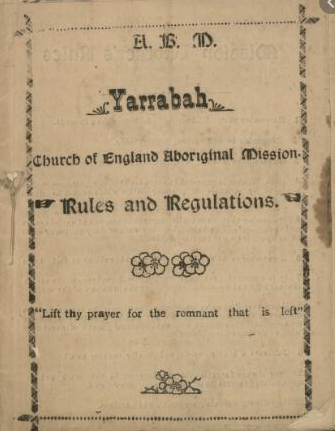 continent by taking charge of the Forrest River Mission in the Kimberley, of which he was head from 1914 until 1927. Ernest Gribble suffered a complete mental breakdown in mid-1927 at the same time as two police he had accused of the so-called Forrest River Massacres were acquitted. However, he had also had an earlier breakdown at Yarrabah in 1909 when he was hospitalised for several weeks.
continent by taking charge of the Forrest River Mission in the Kimberley, of which he was head from 1914 until 1927. Ernest Gribble suffered a complete mental breakdown in mid-1927 at the same time as two police he had accused of the so-called Forrest River Massacres were acquitted. However, he had also had an earlier breakdown at Yarrabah in 1909 when he was hospitalised for several weeks.
This earlier collapse is passed over without much comment in This Whispering in Our Hearts. Yet it led to Ernest Gribble’s departure from Yarrabah under dramatic circumstances. He was dismissed as head of the mission for serious sexual misconduct. He was even forbidden by the Anglican Bishop of North Queensland, George Frodsham, to return to the mission to retrieve his personal belongings. The incoming Primate of Australia, John Wright, was so outraged at Gribble’s behaviour that he banned him from ever being employed in North Queensland. None of this information, however, is relayed by Henry Reynolds to his readers, even though it was disclosed in a PhD thesis by Christine Halse, which is on his list of recommended reading. All Reynolds says about the events of 1909 is: “An affair with an Aboriginal woman at Yarrabah left him deeply troubled and at war with himself.”
In fact, it was more than an affair. Gribble fathered a child by the Aboriginal matron of the Yarrabah Boys’ Home, Janie Brown. The baby, named Nola, was born on 15 September 1908. At the time, Gribble was married, although his wife lived at the mission only intermittently. He was Janie Brown’s employer, mission superintendent and spiritual guide. In other words, the affair was a betrayal of his responsibilities to the church, to his Aboriginal charges and to all the moral principles he espoused. He would certainly have been at war with himself because, up to this time, he had preached a stern moral code that denounced not only fornication and adultery but, in particular, inter-racial sexual relations. He regarded traditional Aboriginal sexual behaviour as one of the chief reasons why they had to be segregated from the European population. The Aborigines’ licentious attitudes meant that contact with whites would soon produce half-castes who, he argued, were “racially inferior”.
Gribble’s hypocrisy alienated his Aboriginal congregation. He tried desperately to discipline them into silence but he lost both their respect and his authority over them. The management of the mission degenerated into chaos. Gribble finally collapsed. Bishop Frodsham then decided to visit the institution, where the disillusioned parishioners told him the secret. Frodsham, however, was not told there were two more sexual indiscretions by the Gribble family. In 1898, Gribble’s younger brother Bert had made pregnant a fifteen-year-old Aboriginal girl, Jinny Katchewan. Her family claimed she was raped. When she was four months into term, Bert Gribble found a job elsewhere and left Yarrabah. Although Ernest Gribble was superintendent of the mission he took no action. In 1906, his sister Ethel had an affair with a Fraser Island Aboriginal, Fred Wondunna, and became pregnant to him. Her brother tried to use his position to get her twelve month’s leave from the Australian Board of Missions to cover up both the affair and the pregnancy.
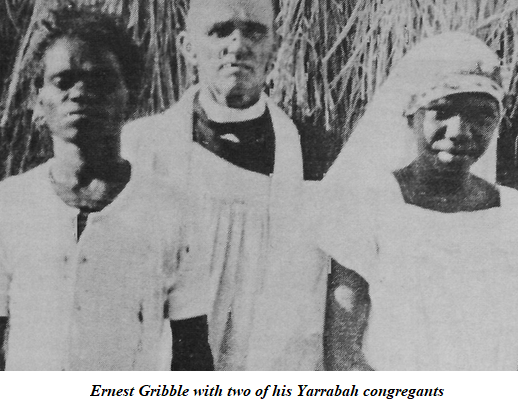
The scene at Yarrabah, with missionaries denouncing inter-racial sex in the daytime but succumbing to the power of Eros during the steamy tropic nights, is like something out of a novel by Somerset Maugham. It was a product of the intense social relationships fostered by the mission model itself. Under the aim of creating a well-disciplined, closed community, the missionaries imposed an all-encompassing authoritarian regime.
Through various forms of compulsion and inducements, especially the offer or withdrawal of rations, parents handed over their children to the mission at ages five or six. In his book Governing Savages (1990) Andrew Markus records the regimen at Yarrabah, observing that most mission settlements at the time adopted much the same model. The children slept in separate dormitories for boys and girls and were locked in from sunset to sunrise. During the day they received religious instruction and were taught to read and write. Contact with parents was limited to Sundays, and then under missionary supervision. For the rest of the week, the older children looked after the younger. The girls remained in their dormitories until they married. When they came of age, courtship was strictly supervised with matches made by the superintendent. Tribal, clan and family marriage preferences for the children were disregarded. The mission took control of their lives.
Often enough, though, Markus says that there were mission Aborigines who sought to defy this authority. These were most often boys raised in the dormitories who, when they became young men, felt compelled to rebel. When this happened, the missionaries came under more intense psychological pressure. Ernest Gribble was known as a man of fierce temper, with no tolerance for anyone thwarting his will. He presided over his own court and personally flogged with a stockwhip those he judged as miscreants. The passion, guilt and anguish involved in trying to resolve all these contradictory impulses goes a long way to explain not only the mental breakdown suffered by Gribble in 1909 but also his behaviour thereafter.
In Massacre Myth, the book exposing the falsity of the claims about the 1926 Forrest River Massacres, Rod Moran says that after 1914, when Gribble arrived to head the mission in the Kimberley, he became sexually involved with more of his charges there as well. He made advances to one of the mission nurses, Sister Violet Claridge, and had a sexual relationship with an Aboriginal woman named Dinah. In a confidential report on the institution to the Australian Board of Missions, the anthropologist, A. P. Elkin, said that in the nearby town of Wyndham the mission was known as “Gribble’s stud farm”. Moran argues that the psychological pressures deriving from the conflict between his public role as a man of righteous authority and his private sexual torment overwhelmed Gribble.
Moreover, the legacy of his father’s experiences and forced exile from Western Australia also weighed heavily on him. In 1925, Ernest Gribble’s son John wrote to the Australian Board of Missions about his father’s erratic behaviour, reporting that on several recent occasions he had threatened suicide. In June that year, the Anglican Bishop of North-West Australia, Gerard Trower, believed Gribble to be mentally unbalanced and withdrew his missionary licence, putting him on notice of his dismissal two years later. “By June 1926,” Moran argues, “Gribble’s mind seems to have disintegrated completely and his grip on reality was tenuous.”
In short, at the very time when Gribble insisted that he had found evidence of what he took to be a series of large-scale massacres on the reserve of his own mission, he was hovering between delusion and insanity. No one in authority should have taken him seriously.
The man, however, had a remarkable resilience. By 1931, he had recovered sufficiently to gain employment with the church once more and to resume his mission to the natives. He returned to North Queensland where, because of his qualifications and experience, he was appointed chaplain of the Palm Island Aboriginal Settlement. For the next 26 years, he worked with a succession of secular superintendents of Palm Island to entrench the penal regime that so offended public opinion when it was finally exposed in 1971. In other words, the longest-serving official on Palm Island, the one constant figure who did more than anyone else to make it a site of such overbearing racism, was Rev. Ernest Gribble. In his homage to Gribble’s career in This Whispering in Our Hearts, Henry Reynolds fails to even mention in passing that he spent more than a quarter of his life on Palm Island.
Gribble ministered to the inmates of Palm Island from 1931 until his death at the age of 88 in 1957. In January that year he was awarded the Order of the British Empire for his services to Aborigines.
This is an edited extract from the last of the three-part series of articles by Keith Windschuttle, ‘The Myths of Frontier Massacres in Australian History’, Quadrant, December 2000
Madam: Archbishop Fisher (July-August 2024) does not resist the attacks on his church by the political, social or scientific atheists and those who insist on not being told what to do.
Aug 29 2024
6 mins
To claim Aborigines have the world's oldest continuous culture is to misunderstand the meaning of culture, which continuously changes over time and location. For a culture not to change over time would be a reproach and certainly not a cause for celebration, for it would indicate that there had been no capacity to adapt. Clearly this has not been the case
Aug 20 2024
23 mins
A friend and longtime supporter of Quadrant, Clive James sent us a poem in 2010, which we published in our December issue. Like the Taronga Park Aquarium he recalls in its 'mocked-up sandstone cave' it's not to be forgotten
Aug 16 2024
2 mins







